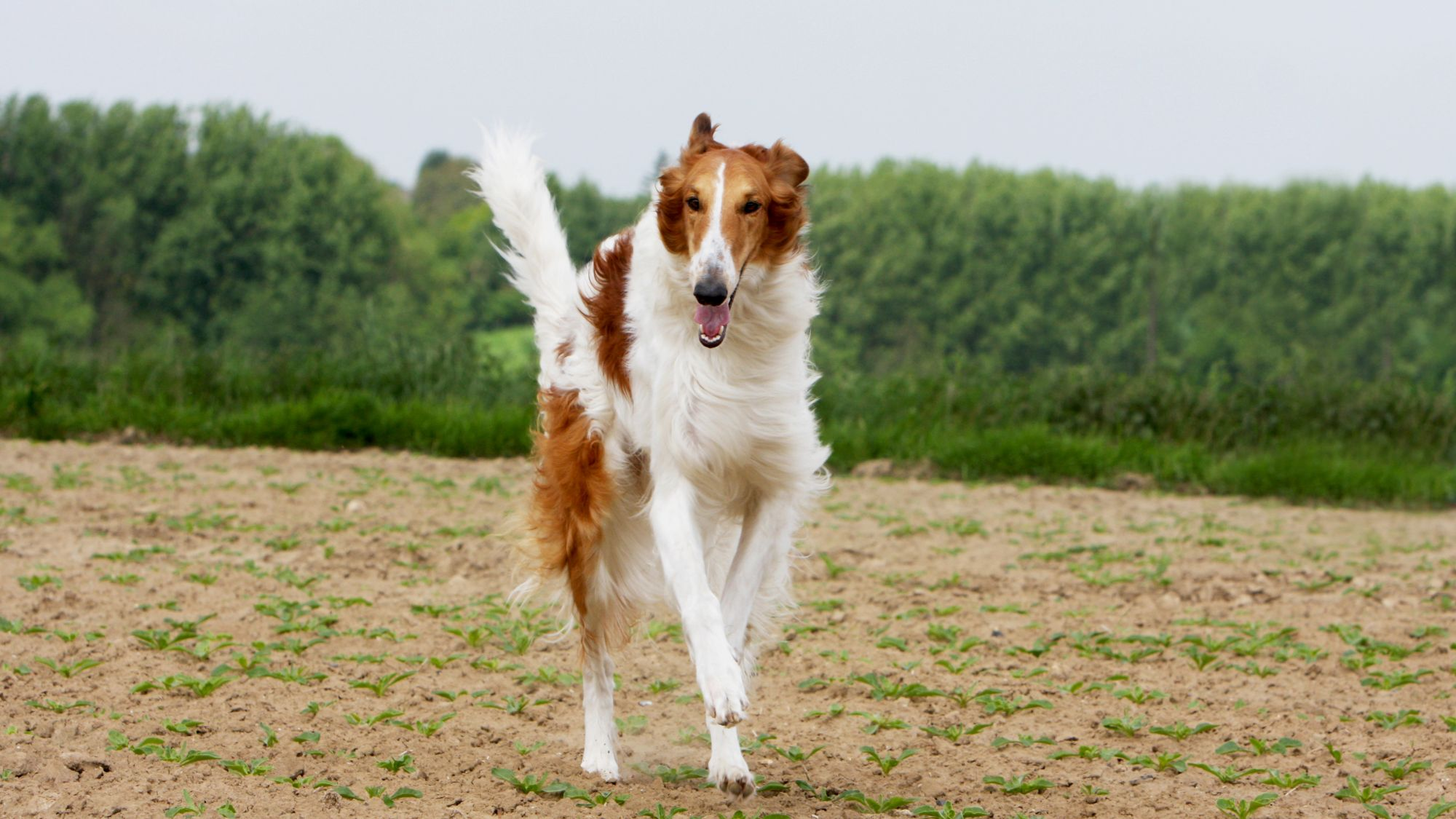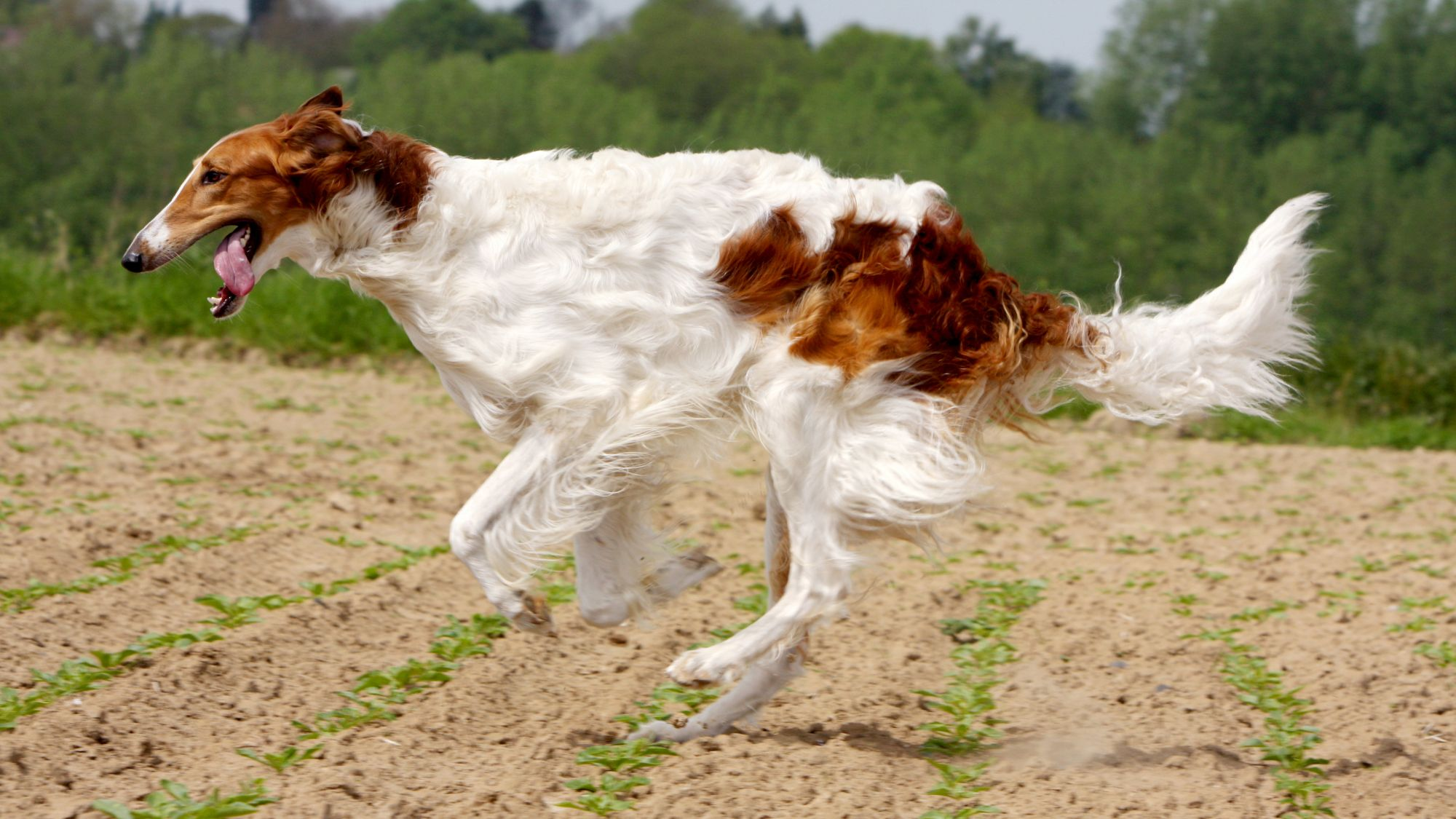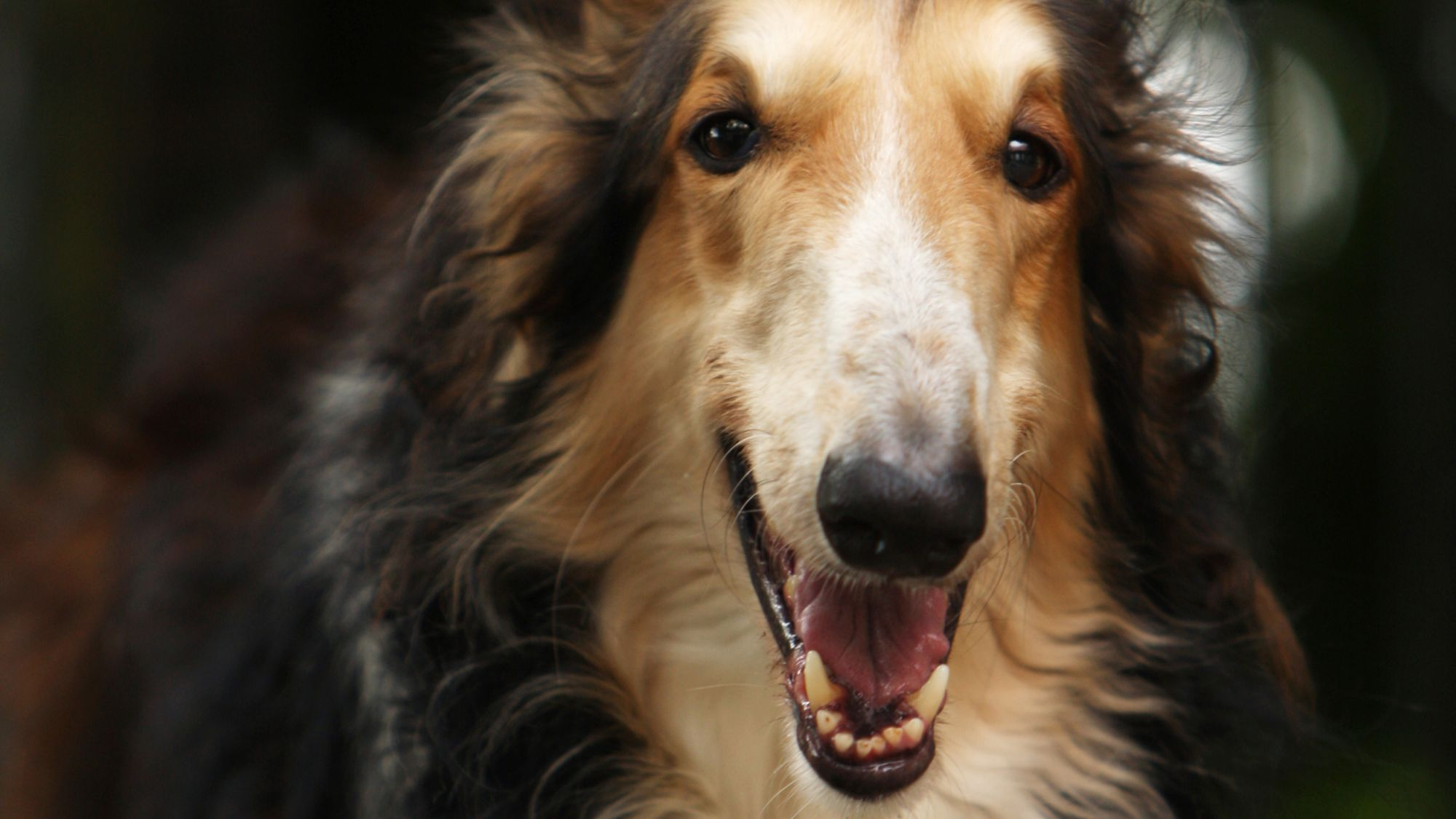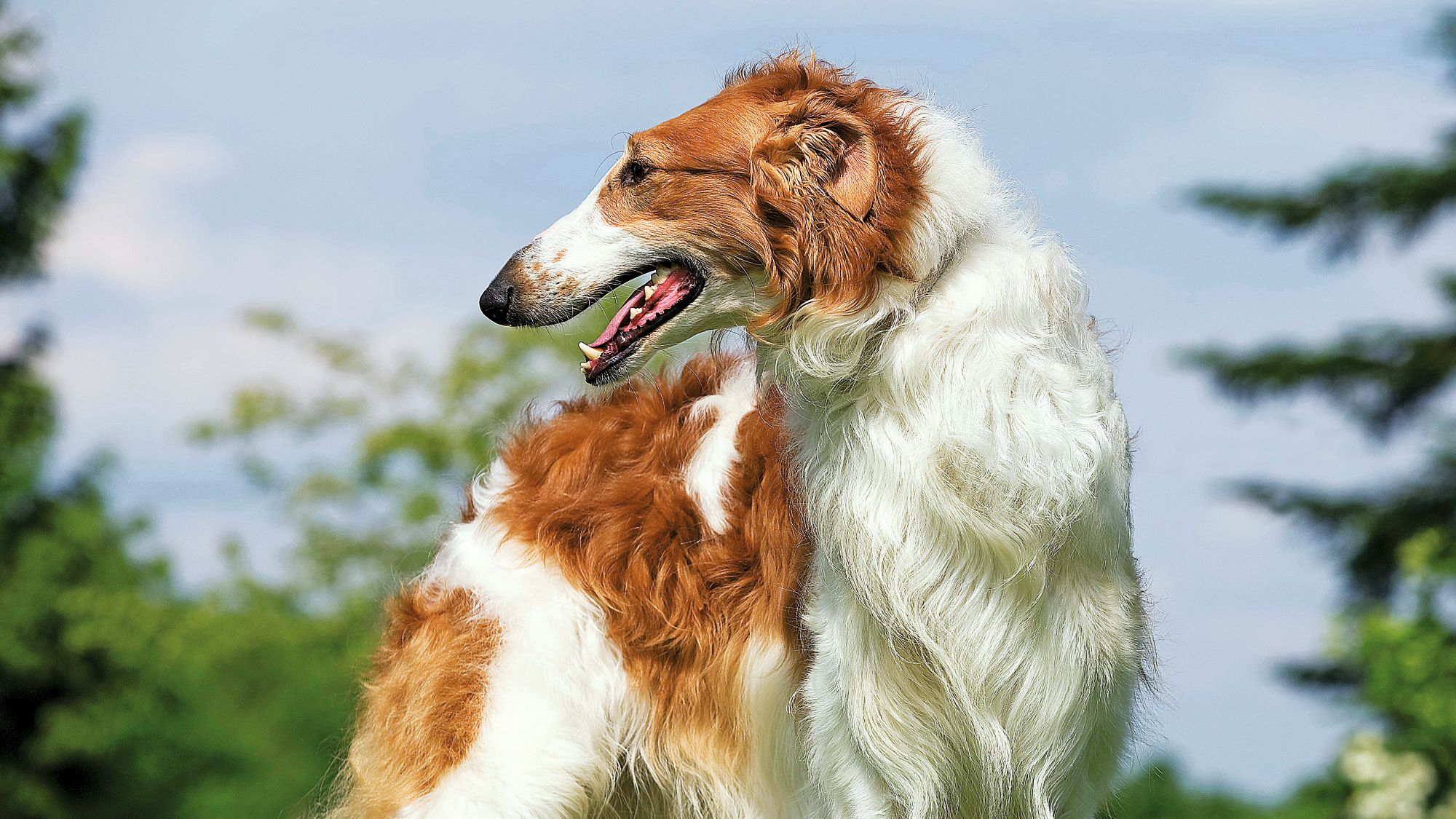
Let's talk Borzois
Stately, graceful, and poised, the Borzoi was originally bred by Russian nobility to chase down prey on extravagant hunting expeditions. The Borzoi is a sighthound with a full coat of lustrous hair and a lean, muscular body that can sprint at up to 40 miles an hour (64km/h). Their impressive, streamlined build rightly suggests rare athletic prowess; however, there’s much more to the Borzoi than speed. Behind their innate elegance, the Borzoi is a sweet, affectionate breed and, with the right training, can become a wonderful family companion.Official name: Borzoi
Other names: Russian Wolfhound, Russkaya Psovaya Borzaya
Origins: Russia

| Drooling tendencies |
|
Warm weather? | |
| Shedding level | Suited to apartment living? | ||
| Energy level (high, low, medium) *: | Low to moderate | Family Pet?* |
|
| Compatibility with other pets |  |
Can stay alone?* |
* We advise against leaving pets alone for long stretches. Companionship can prevent emotional distress and destructive behaviour. Speak to your veterinarian for recommendations.
Every pet is different, even within a breed; this snapshot of this breed’s specifics should be taken as an indication.
For a happy, healthy and well-behaved pet, we recommend educating and socialising your pet as well as covering their basic welfare, social and behavioural needs.
Pets should never be left unsupervised with a child.
All domestic pets are sociable and prefer company. However, they can be taught to cope with solitude from an early age. Seek the advice of your veterinarian or trainer to help you do this.


| Baby age: | Birth to 2 months |
| Puppy age: | 2 to 15 months |
| Adult age: | 15 months to 5 years |
| Mature age: | 5 to 8 years |
| Senior age: | from 8 years |

1/7
Get to know the Borzoi
All you need to know about the breed
The canine embodiment of grace and beauty, the Borzoi was originally bred by Russian aristocracy as a hunting and coursing dog, prized for their speed and agility. One of the tallest sighthound breeds, the naturally aristocratic Borzoi may look like it belongs in an 18th-century oil painting of a royal hunt; however, the affectionate Borzoi would much rather be with their human families.
As for their appearance, the Borzoi is tall and narrow with long, muscular limbs that ooze elegance with every move. Thanks to the Borzoi’s silky double coat that comes in all colours and varies from straight to wavy to full-on curly, the breed does well in cold weather—not surprising considering they were bred to endure frigid Russian winters. While Borzois do require consistent grooming, they actually clean their own coats much like cats do. Can we get a meow with that bark?
Intelligent and calm, the Borzoi can be stubborn. Firm but gentle training given with natural authority will get the best results. A one-family kind of dog, the Borzoi is neutral if not friendly with strangers. To ensure their best behaviour around small children and other animals, it’s best to socialise your Borzoi as early as possible.
And while the Borzoi adapts well to indoor life, their sofa-surfing should be counterbalanced with plenty of regular exercise. Just remember: The Borzoi is prone to chase at every opportunity. Your Borzoi should remain on the lead in unfenced areas. They can always satisfy their need for speed in a secure, enclosed space!

2/7
2 facts about Borzois
1. Eye see you over there!
The Borzoi is a sighthound, a term that refers to the breed’s impressive vision. The Borzoi breed’s forward-facing eyes afford them a 270-degree sight range, which leaves humans’ 180-degree field of vision in the dust! Borzois also have a line of vision cells across their retina known as a vision streak. This trait, found only in sighthounds, retrievers and certain hunting dogs, enables the Borzoi to spot prey from great distances.
2. Flirting with Fame
The Borzoi has enjoyed several “fifteen minutes of fame” over the years. The captain of the ill-fated Titanic owned a Borzoi, though, luckily, the pooch wasn’t aboard when catastrophe struck. The Borzoi was also a favourite canine companion during the Art Deco movement thanks to their elegant looks and could be seen alongside stars like Jean Harlow and Sara Bernhardt as well as in the pages of Vogue. And let us not forget Nobs, the Borzoi who rose to rock star status by laying the “vocal” track for Pink Floyd’s 1971 song entitled “Mademoiselle Nobs”.
History of the breed
The Borzoi breed can be traced back to 17th century Russia, where nobles crossed Arabian greyhounds with Russian sheep dogs to produce a fast, impervious-to-weather breed capable of chasing down and tackling rabbits, foxes and wolves. These lavish, large-scale hunts were a cherished tradition of Russian nobility for centuries involving up to one hundred Borzois and just as many servants.
The emancipation of Russian serfs in 1861 meant such large-scale hunting expeditions were no longer possible and the Borzoi population sharply declined. Soon afterward, the breed’s connection to the aristocracy proved lethal as many met the same demise as their owners after the Russian Revolution of 1917.
Luckily, the Borzoi was spared from extinction thanks to a few dogs offered as gifts to royals overseas and others imported by foreigners, namely in Britain and America, where breeding programs were soon established.
First registered by the AKC in 1891, the Borzoi was still known to the English-speaking world as the Russian Wolfhound. However, this changed in 1936, when it was decided to rename them Borzoi, after the Russian word “borzii”, meaning swift.

4/7
From head to tail
Physical characteristics of Borzois
1. Head
Head is long, narrow and lean, with dark, almond-shaped eyes.
2. Ears
Ears are small and fine with pointed tips.
3. Body
Powerful neck, deep, narrow chest and long, muscular hindquarters.
4. Coat
Coat is silky and long on body while short on head, ears and front of legs.
5. Tail
Tail is long and thin with dense, feathered hair.

5/7
Things to look out for
From specific breed traits to a general health overview, here are some interesting facts about your Borzoi

6/7
Caring for your Borzoi
Grooming, training and exercise tips
Giving your Borzoi coat a quick brush every 1 to 2 days with a pin or slicker brush will keep excess hair and dirt to a minimum, and regular nail-trimming will ensure their comfort. Borzois do shed heavily for several weeks about once a year, during which time they should be groomed more frequently. But it seems only fair that regal beauty like this should require a little work. The athletic Borzoi does need at least an hour of exercise every day, whether it’s walking or running alongside your bike, and always on a lead. Prone to sprinting with a strong drive to chase, Borzois can and will bolt, which is why they should always be kept on a leash when outside a fenced-in area. While generally mild-mannered with a great capacity for learning, the Borzoi can be stubborn. Early training and socialisation given with firm patience by someone with natural authority will help bring out the best in your Borzoi.7/7
All about Borzois
The Borzoi is a natural sprinter-chaser and will tend to see other animals such as cats as potential prey. This is where early training and exposure to cats is key and will determine the outcome of their cohabitation.
Borzois should get regular exercise, affection, and grooming—just like countless other breeds. That said, the Borzoi is generally laid back and not particularly high maintenance. Looks can be deceiving.
translations.feature.breeds.otherbreeds
Read more on this topic

How your dog's nutrition needs change with age

How to adopt a dog

Things to consider before getting a dog
Sources
1 - Veterinary Centers of America https://vcahospitals.com/
2 - Royal Canin Dog Encyclopaedia. Ed 2010 and 2020
3 - Banfield Pet Hospital https://www.banfield.com/
4 - Royal Canin BHN Product Book
5 - American Kennel Club https://www.akc.org/


